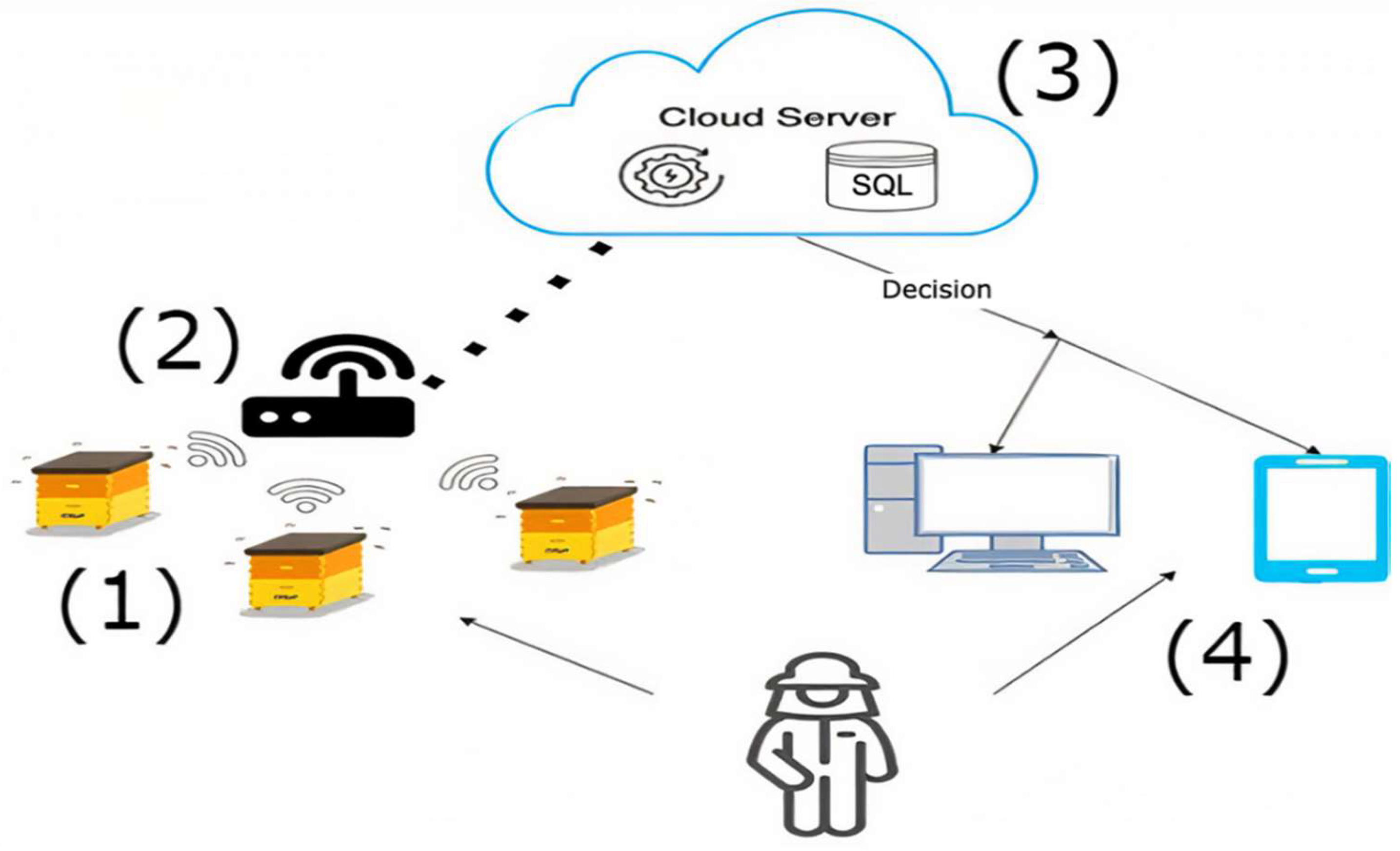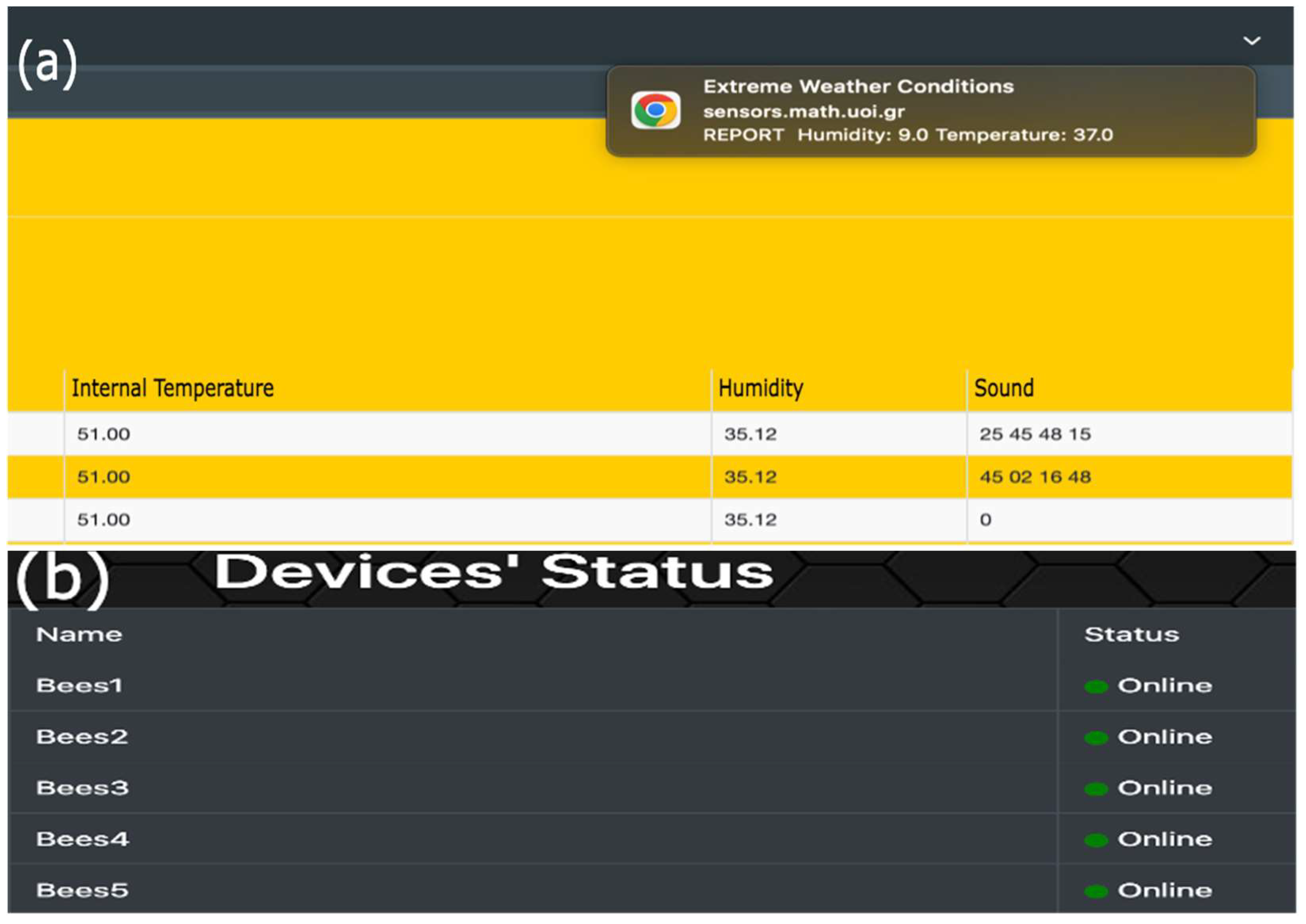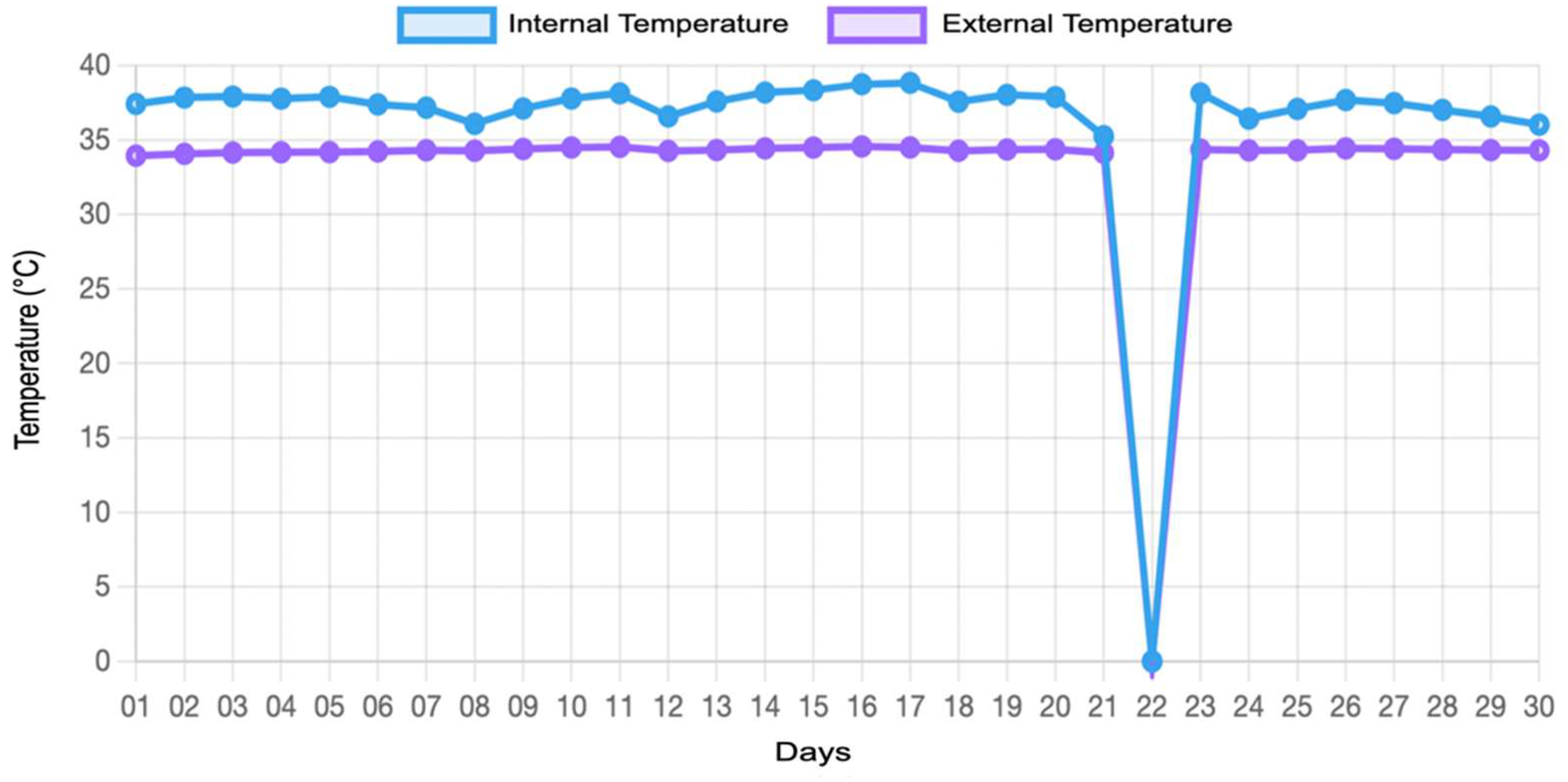Bee Sound Detector: An Easy-to-Install, Low-Power, Low-Cost Beehive Conditions Monitoring System
Abstract
:1. Introduction
2. Related Work
3. Proposed High-Level BeeSD System Architecture
3.1. BeeSD IoT Device Component
- The four-core ARM CPU (main processor unit), where the sensors are attached. The card reader contains a MicroSD card of 32 GB, which contains the appropriate scripts and storage for the extracted files.
- A waterproof temperature sensor probe that returns the targeted temperature values amongst frames inside the beehive.
- The lavalier microphone that is used to record the sounds made by the bees, stored in raw WAV data files.
- The temperature and humidity sensor attached to the lid monitor the temperature and the relative humidity values inside the beehive.
- A micro-USB cable that used to power the ARM CPU via the PV panel component.
- A power actuator that switches the device on and off as scheduled.
3.2. BeeSD Services and Service Capabilities
- Audio data-logging service;
- Sensory measurements logging service;
- Synchronization service;
- Monitoring and probing service;
- Cloud processing service;
- Push notification service;
- Statistical trends service.
4. BeeSD System Experimentation
4.1. BeeSD Key Performance Indicators
4.2. BeeSD End-Node Device Power Consumption
4.3. BeeSD Data-Logging Upload Experiments
5. Conclusions
Author Contributions
Funding
Conflicts of Interest
References
- Etxegarai-Legarreta, O.; Sanchez-Famoso, V. The Role of Beekeeping in the Generation of Goods and Services: The Interrelation between Environmental, Socioeconomic, and Sociocultural Utilities. Agriculture 2022, 12, 551. [Google Scholar] [CrossRef]
- Fitzgerald, D.W.; Murphy, F.E.; Wright, W.M.; Whelan, P.M.; Popovici, E.M. Design and development of a smart weighing scale for beehive monitoring. In Proceedings of the 2015 26th Irish Signals and Systems Conference (ISSC), Carlow, Ireland, 24–25 June 2015; pp. 1–6. [Google Scholar] [CrossRef]
- Kviesis, A.; Zacepins, A. System architectures for real-time bee colony temperature monitoring. Procedia Comput. Sci. 2015, 43, 86–94. [Google Scholar] [CrossRef]
- Cecchi, S.; Terenzi, A.; Orcioni, S.; Piazza, F. Analysis of the sound emitted by honey bees in a beehive. In Proceedings of the Audio Engineering Society Convention 147, New York, NY, USA, 16–19 October 2019. [Google Scholar]
- Voudiotis, G.; Kontogiannis, S.; Pikridas, C. Proposed Smart Monitoring System for the Detection of Bee Swarming. Inventions 2021, 6, 87. [Google Scholar] [CrossRef]
- Milota, M. Beehive Security System against Unauthorized Manipulation. In Proceedings of the 27th Conference EEICT 2021, Brno, Czech Republic, 27 April 2021. [Google Scholar]
- Bellos, C.V.; Fyraridis, A.; Stergios, G.S.; Stefanou, K.A.; Kontogiannis, S. A Quality and disease control system for beekeeping. In Proceedings of the 2021 6th South-East Europe Design Automation, Computer Engineering, Computer Networks and Social Media Conference (SEEDA-CECNSM), Preveza, Greece, 24–26 September 2021; pp. 1–4. [Google Scholar] [CrossRef]
- Meikle, W.; Holst, N. Application of continuous monitoring of honeybee colonies. Apidologie 2015, 46, 10–22. [Google Scholar] [CrossRef]
- Gates, B.N. The Temperature of the Bee Colony; Number 96; US Department of Agriculture: Washington, DC, USA, 1914. [Google Scholar]
- Jiang, J.A.; Wang, C.H.; Chen, C.H.; Liao, M.S.; Su, Y.L.; Chen, W.S.; Huang, C.P.; Yang, E.C.; Chuang, C.L. A WSN-based automatic monitoring system for the foraging behavior of honey bees and environmental factors of beehives. Comput. Electron. Agric. 2016, 123, 304–318. [Google Scholar] [CrossRef]
- Murphy, F.E.; Popovici, E.; Whelan, P.; Magno, M. Development of an heterogeneous wireless sensor network for instrumentation and analysis of beehives. In Proceedings of the 2015 IEEE International Instrumentation and Measurement Technology Conference (I2MTC) Proceedings, Pisa, Italy, 11–14 May 2015; pp. 346–351. [Google Scholar] [CrossRef]
- Zabasta, A.; Zhiravetska, A.; Kunicina, N.; Kondratjevs, K. Technical Implementation of IoT Concept for Bee Colony Monitoring. In Proceedings of the 2019 8th Mediterranean Conference on Embedded Computing (MECO), Budva, Montenegro, 10–14 June 2019; pp. 1–4. [Google Scholar] [CrossRef]
- Zacepins, A.; Kviesis, A.; Pecka, A.; Osadcuks, V. Development of internet of things concept for precision beekeeping. In Proceedings of the 2017 18th International Carpathian Control Conference (ICCC), Sinaia, Romania, 28–31 May 2017; pp. 23–27. [Google Scholar] [CrossRef]
- Gil-Lebrero, S.; Quiles-Latorre, F.J.; Ortiz-López, M.; Sánchez-Ruiz, V.; Gámiz-López, V.; Luna-Rodrguez, J.J. Honey bee colonies remote monitoring system. Sensors 2016, 17, 55. [Google Scholar] [CrossRef]
- Mrozek, D.; Gȯrny, R.; Wachowicz, A.; Małysiak-Mrozek, B. Edge-Based Detection of Varroosis in Beehives with IoT Devices with Embedded and TPU-Accelerated Machine Learning. Appl. Sci. 2021, 11, 11078. [Google Scholar] [CrossRef]
- Bilik, S.; Kratochvila, L.; Ligocki, A.; Bostik, O.; Zemcik, T.; Hybl, M.; Horak, K.; Zalud, L. Visual Diagnosis of the Varroa Destructor Parasitic Mite in Honeybees Using Object Detector Techniques. Sensors 2021, 21, 2764. [Google Scholar] [CrossRef]
- Cecchi, S.; Spinsante, S.; Terenzi, A.; Orcioni, S. A smart sensor-based measurement system for advanced bee hive monitoring. Sensors 2020, 20, 2726. [Google Scholar] [CrossRef] [PubMed]
- Zgank, A. IoT-Based Bee Swarm Activity Acoustic Classification Using Deep Neural Networks. Sensors 2021, 21, 676. [Google Scholar] [CrossRef] [PubMed]
- Imoize, A.L.; Odeyemi, S.D.; Adebisi, J.A. Development of a Low-Cost Wireless Bee-Hive Temperature and Sound Monitoring System. Indones. J. Electr. Eng. Inform. 2020, 8, 476–485. [Google Scholar] [CrossRef]
- Ngo, T.N.; Wu, K.C.; Yang, E.C.; Lin, T.T. A real-time imaging system for multiple honey bee tracking and activity monitoring. Comput. Electron. Agric. 2019, 163, 104841. [Google Scholar] [CrossRef]
- Marchal, P.; Buatois, A.; Kraus, S.; Klein, S.; Gomez-Moracho, T.; Lihoreau, M. Automated monitoring of bee behaviour using connected hives: Towards a computational apidology. Apidologie 2020, 51, 356–368. [Google Scholar] [CrossRef]
- Kontogiannis, S. An internet of things-based low-power integrated beekeeping safety and conditions monitoring system. Inventions 2019, 4, 52. [Google Scholar] [CrossRef]
- Kviesis, A.; Zacepins, A.; Durgun, M.; Tekin, S. Application of wireless sensor networks in precision apiculture. In Proceedings of the 14th International Scientific Conference Engineering for Rural Development, Jelgava, Latvia, 20–22 May 2015; Volume 20, pp. 440–445. [Google Scholar]
- Zygi Company. Digital Scales for Measuring Beehive Weight and Respond to Critical Incidents, Product. 2017. Available online: http://zygi.gr (accessed on 19 May 2020).
- 3Bee Company. Hive-Tech, the Innovative Monitoring System for Beekeeping. 2017. Available online: https://www.3bee.it/en/hive-tech (accessed on 27 September 2022).
- Arnia Company. Remote Hive Monitoring System with Alerts. 2018. Available online: http://www.arnia.co.uk (accessed on 27 September 2022).
- Tomtsis, D.; Kokkonis, G.; Kontogiannis, S. Evaluating existing wireless technologies for IoT data transferring. In Proceedings of the 2017 South Eastern European Design Automation, Computer Engineering, Computer Networks and Social Media Conference (SEEDA-CECNSM), Kastoria, Greece, 23–25 September 2017; pp. 1–4. [Google Scholar] [CrossRef]






| Category | Description | IoT Devices and Sensors Used |
|---|---|---|
| C1: CCD famine | Colony Collapse Disorder (CCD) due to famine and lack of feeding resources (pollen) | Cameras and weight scales [2] |
| C2: Environmental factors | Extreme environmental conditions due to climate change. Very low/high temperatures. Extended low/high humidity due to rainfalls/aridity | Temperature and humidity sensors. Meteorological stations [3] |
| C3: Swarming | CCD due to swarming | Weight scales and microphones [4] |
| C4: Queen loss | CCD due to queen mortality | - |
| C5: Diseases/Parasites | Varroa mite, bee Nosema fungus | Cameras experimentally, in some cases only [5] |
| C6: External attacks | Mammals, wasps, hornets | Cameras, vibration sensors, gyroscopes, GPS [6] |
| Key Performance Indicator | In-Process KPI |
|---|---|
| KPI 1: Low energy | Continuous operation of at least 90 days. |
| KPI 2: Easy to install | All components are placed on the lid, including the battery (maximum of 10,000 mAh). Batteries with capacities higher than 10,000mAh cannot fit inside the beehive lid, and their weight makes them hard to attach and operate (remove the battery, charge it, and place it back to the lid case). |
| KPI 3: Low cost | Scalability of 5–10 beehives per concentrator. Integration of more than 10 beehives per concentrator (20–50) quadruples the concentrator cost and doubles the cost of the required battery and photovoltaic (PV) panel needed to maintain the concentrator’s autonomous operation. |
| Status | Temperature and Humidity Sensor | Temperature Sensor Probe | Microphone (USB) |
|---|---|---|---|
| Active | 0.5 mA | 1.5 mA | 82 mA |
| Standby | 100 nA | 700 nA | 70 mA |
| Average | 0.2 mA | 1 mA | 75 mA (before disabling |
| 2 mA (after disabling) |
| Number of Daily Probes | Total Size (MB) | Total Time n = 1 (min) | Total Time n = 5 (min) | Total Time N = 10 (min) |
|---|---|---|---|---|
| 5 | 9.51 | 8.15 | 13.32 | 34.33 |
| 12 | 22.81 | 16.30 | 26.64 | 68.66 |
| 24 | 45.61 | 39.11 | 63.92 | 164.77 |
| 48 | 91.21 | 78.23 | 127.84 | 329.53 |
| 64 | 121.61 | 104.30 | 170.45 | 439.37 |
| 128 | 243.21 | 208.60 | 340.89 | 878.73 |
| Number of Daily Probes | Days of Operation (n = 1) | Days of Operation (n = 5) | Days of Operation (n = 10) |
|---|---|---|---|
| 5 | 294.51 | 180.18 | 69.9 |
| 12 | 147.26 | 90.1 | 34.95 |
| 24 | 61.36 | 37.55 | 14.56 |
| 48 | 30.68 | 18.77 | 7.28 |
| 64 | 23.01 | 14.08 | 5.46 |
| 128 | 11.51 | 7.04 | 2.73 |
Publisher’s Note: MDPI stays neutral with regard to jurisdictional claims in published maps and institutional affiliations. |
© 2022 by the authors. Licensee MDPI, Basel, Switzerland. This article is an open access article distributed under the terms and conditions of the Creative Commons Attribution (CC BY) license (https://creativecommons.org/licenses/by/4.0/).
Share and Cite
Kiromitis, D.I.; Bellos, C.V.; Stefanou, K.A.; Stergios, G.S.; Katsantas, T.; Kontogiannis, S. Bee Sound Detector: An Easy-to-Install, Low-Power, Low-Cost Beehive Conditions Monitoring System. Electronics 2022, 11, 3152. https://doi.org/10.3390/electronics11193152
Kiromitis DI, Bellos CV, Stefanou KA, Stergios GS, Katsantas T, Kontogiannis S. Bee Sound Detector: An Easy-to-Install, Low-Power, Low-Cost Beehive Conditions Monitoring System. Electronics. 2022; 11(19):3152. https://doi.org/10.3390/electronics11193152
Chicago/Turabian StyleKiromitis, Dimitrios I., Christos V. Bellos, Konstantinos A. Stefanou, Georgios S. Stergios, Thomas Katsantas, and Sotirios Kontogiannis. 2022. "Bee Sound Detector: An Easy-to-Install, Low-Power, Low-Cost Beehive Conditions Monitoring System" Electronics 11, no. 19: 3152. https://doi.org/10.3390/electronics11193152
APA StyleKiromitis, D. I., Bellos, C. V., Stefanou, K. A., Stergios, G. S., Katsantas, T., & Kontogiannis, S. (2022). Bee Sound Detector: An Easy-to-Install, Low-Power, Low-Cost Beehive Conditions Monitoring System. Electronics, 11(19), 3152. https://doi.org/10.3390/electronics11193152








